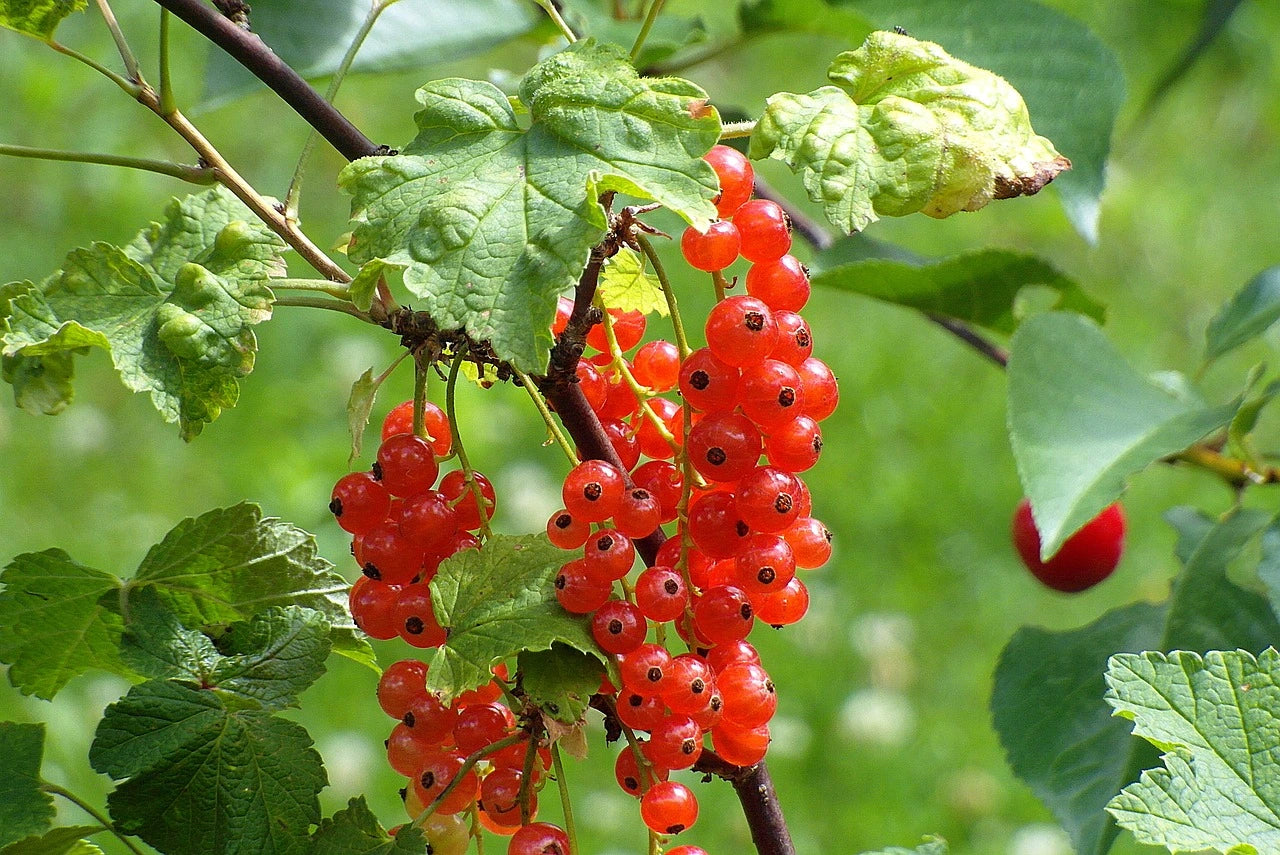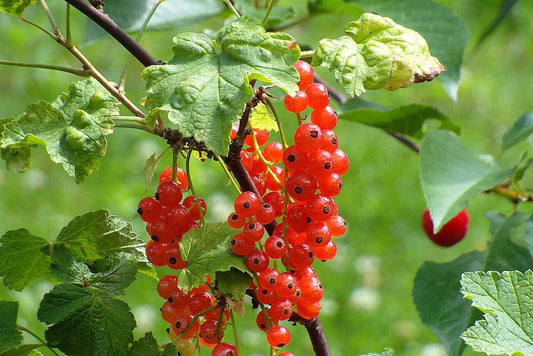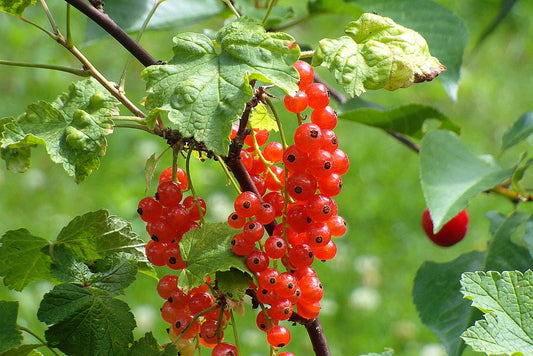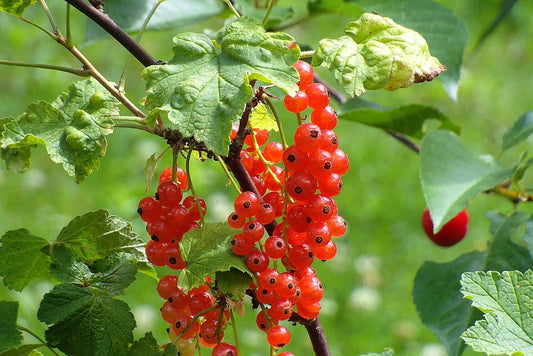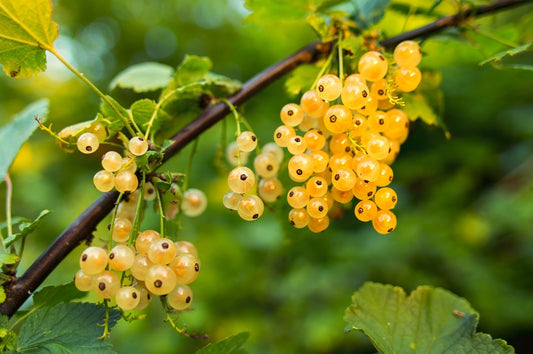-
Delivery from 10 plants within 15 days FR/ EU / CH
Delivery Terms -
Wholesale Supplier of Small Fruit Plants
About Us -
Quality Small Fruit Plants
Technical itinerary for small fruits -
Secure payment
Our Payment Terms
ORGANIC CURRANT BUSH plant La Turinoise - 1.6 liter pot
ORGANIC CURRANT BUSH plant La Turinoise - 1.6 liter pot
Price € excluding VAT per unit excluding transport. Our prices are based on volume. We offer you the best option based on your needs.
Couldn't load pickup availability
 Buy now and get it delivered when you're ready to plant - Add your desired date to your quote request
Buy now and get it delivered when you're ready to plant - Add your desired date to your quote request
 Delivery from 10 plants within 15 days FR/ EU / CH
Delivery from 10 plants within 15 days FR/ EU / CH
This small fruit plant is a 1.6 litre potted plant
This plant is stored in a 1.6 liter pot. These plants are more robust than potted or bare-root plants because they are more mature. The potted packaging allows the plant to store water and nutrients and thus allows storage before planting in the ground. However, excessive storage should be avoided to prevent the roots from twisting, which would reduce the plant's ability to recover.
These small fruit plants for professionals are certified organic AB
Buying professional organic berry plants from AB allows you to produce organically. Fruits can be sold organically.
Quand Planter / Quand Récoler les Groseilliers à grappes ?
Vous souhaitez cultiver des groseilles à grappes mais vous ne savez pas quand les planter ? Vous souhaitez savoir quand vous allez récolter ? Consulter notre Calendrier de plantation et récolte pour les Groseilliers à grappes
View full details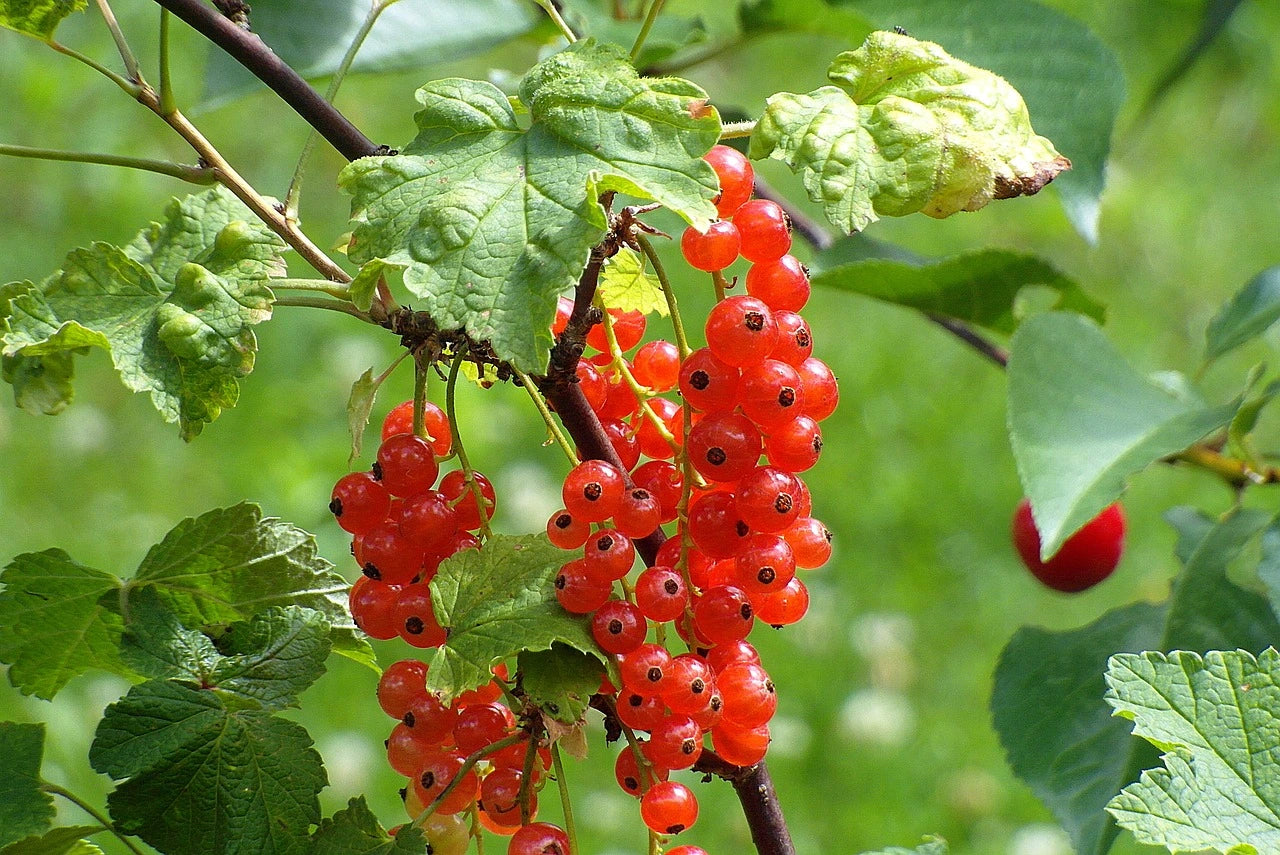
Our quality Gooseberry Bushes for professional market gardeners
Quick read / the essentials on Gooseberry Rovada
The Rovada Grape Currant is today one of the most popular varieties among professionals for its long, regular bunches and high-quality late production. Cultivated in both conventional and organic farming, this variety is distinguished by its vigor, its natural tolerance to diseases and its excellent yield. At Bairiverse , we make it a point of honor to select and offer robust plants, from reputable partner nurseries, in order to guarantee optimal technical and commercial performance.
As a specialist wholesale supplier of small fruit plants , we offer market gardeners and nurserymen a wide selection of Rovada Gooseberry plants in different formats: cells, pots, 1 to 4 liter pots, bare roots or mini-plugs. These varied packaging meet the needs of rapid establishment, resale in garden centers or production in the open ground. Our plants are available in organic, untreated or conventional versions, to adapt to all technical routes.
Buying Gooseberry plants in Grappes Rovada from our network means benefiting from personalized support, expert agronomic advice, and exceptional value for money. Whether you are a short-circuit producer, processor, or a large-scale grower, we have the solution adapted to your objectives. Trust Bairiverse , your specialist wholesale supplier of small fruit plants , for quality, sustainable, and profitable cultivation. We allow you to buy Gooseberry plants in Grappes Rovada with complete peace of mind, with fast deliveries and professional technical support. Choose a specialist wholesale supplier of small fruit plants who understands your production challenges.
Presentation of our range of Gooseberry Bushes
We offer a wide range of gooseberry plants , rigorously selected to meet the expectations of professional market gardeners, specialist arboriculturists and nurserymen . Available in organic, untreated and conventional versions , our plants are suitable for all types of technical itineraries.
Our offer is available in the following formats:
- Wide range of small fruit plants in alveoli , for quick and efficient planting
- Plants in mini-clods in trays of 77 units , compatible with mechanical transplanting
- Horticultural pots of 7, 8 or 9 cm , ensuring good recovery in cultivation
- 1L, 1.5L, 1.6L, 2L and 4L pots , suitable for direct sale or late planting
- Bare root plants , economical size, ideal for fall and winter planting
- Ready-to-pot plants , intended for nurseries and resale channels
Our gooseberry bushes are produced by specialist nurseries , selected for the genetic, health and agronomic quality of their plants. We ensure fast and careful delivery , to your plot, in store or directly to your farm , within 15 days depending on availability.
Gooseberry cultivation in France: current status and potential
The redcurrant, a fruit tree with small, tangy fruits, represents a niche crop with high added value , particularly suited to short supply chains, artisanal processing and direct sales.
European positioning
With a production of less than 2,000 tonnes, France ranks 6th in Europe , far behind Poland (35,000 t), Germany (7,000 t) and the Netherlands (4,000 t). The French market is therefore mainly supplied by imports , particularly from the Netherlands, Spain and Chile.
Characteristics of French production
- Gradual decline in surface area : 400 ha in 2017, 280 ha in 2020
- Geographic distribution : Rhône-Alpes (19%), Auvergne (18%), Île-de-France (12%)
- Fragmented production : 82% of farms have less than 2,000 m² of cultivation
This fragmentation makes the market less competitive, but opens up opportunities for structured producers capable of meeting qualitative demand.
Outlets and circuits
- 95% of the production of similar red fruits (e.g. blackcurrants) is intended for processing
- Around 1,300 tonnes of gooseberries are sold fresh
- Evolution towards GMS , to the detriment of the catering circuit
Market, prices and outlook
Imports and self-sufficiency rates
The self-sufficiency rate of currants is 50% , which indicates a strong potential for local substitution .
Imports (Netherlands, Spain, Chile) remain stable at around 1,000 tonnes per year , unlike other small fruits whose volumes are exploding.
Observed prices (March 2025)
- Lyon-Corbas: €29.60 excluding VAT/kg (125g tray, origin Netherlands)
- MIN Avignon-Cavaillon: €4.50 excluding VAT/125g
- MIN Nice: €37.00 excluding VAT/kg
- MIN Rungis: €32.00 excluding VAT/kg
These high prices underline the premium positioning of currants, used mainly in baking and culinary decoration .
Trends and opportunities
- 11% increase in turnover in 2023 for processed fruits
- Stable market but not very competitive in national production
- Growing demand for organic and natural fruits
Organic Gooseberry Market: Current Dynamics
Organic offer and varieties available
More and more nurseries are offering certified organic gooseberry bushes , with varieties such as:
- 'Rovada' : very productive, long bunch, late harvest
- 'Wilder' : vigorous, adapted to temperate climates
- 'Jonkheer Van Tets' : resistant and early, well adapted to organic farming
Specific practices in organic farming
- Organic fertilization , addition of compost and fermented extracts
- Preventive control of diseases (anthracnose, powdery mildew)
- Managed grassing or mulching for weed control
Added value of organic fruits
Organic currants command a price premium , more than offsetting lower yields. This positioning is ideal for direct sales, artisanal processors , or specialized channels.
Our commitments for professionals
By choosing our gooseberry bushes , you benefit from strong guarantees to secure your plantations and optimize your performance:
- The widest range of gooseberry bushes in France , in sizes suitable for all uses
- Professional quality plants , grown in France or in Europe according to strict specifications
- Smooth supply , without disruption or logistical complications
- Delivery to your farm, store or home
- Quote within 48 hours , personalized and free
- Dedicated technical support , with cultivation itineraries for market gardeners
- Responsive after-sales service , in direct contact with our producers
- Producer prices , with discounts depending on quantities
We are specialists in the production of small fruits , and our teams are at your disposal to assist you in the choice of varieties , the planning of your plants , and post-planting technical monitoring .
General Presentation of the Gooseberry (Ribes rubrum)
The redcurrant ( Ribes rubrum ) is a perennial fruit species widely cultivated in France for the production of currants, small red or white berries depending on the variety. Appreciated both for fresh consumption and for processing (jams, juices, syrups), these sweet and tangy berries are the subject of technical cultivation mastered by professional producers.
Botanical Description and Life Cycle
A fruit shrub of the Grossulariaceae family, the gooseberry is a perennial plant that reaches full production from the 4th year after planting. Its productive lifespan is estimated at between 15 and 20 years. It follows an annual growth cycle, with flowering in spring and fruiting in summer.
Planting and Soil Preparation
Successful planting begins with a soil test to check pH (ideally between 6.0 and 6.5) and nutrient content. The soil should be worked deeply (plowing to a depth of 30-40 cm, subsoiling if necessary) to ensure good drainage. Organic amendment (composted manure or compost) improves structure and fertility. The recommended spacing is 1 to 1.5 m between plants and 2.5 to 3 m between rows, or a density of 2,000 to 4,000 plants per hectare.
Irrigation
The gooseberry bush has regular water requirements, especially during fruit growth and ripening. Precise and economical drip irrigation is the most effective method. It uses 2-4 L/h drippers spaced 30-50 cm apart. Tensiometers help control irrigation to maintain optimal soil moisture (60-80% of field capacity).
Fertilization
Balanced nutrition is essential for good production. In conventional farming, balanced or potassium-rich NPK fertilizers are used, with fractional applications. In organic farming, compost, manure, green manures, bone meal, and wood ash are preferred. Foliar fertilization can also supplement these applications.
Pollination
Although the gooseberry bush is self-fertile, the presence of pollinating insects significantly improves the yield and quality of the fruit (up to +20%). The installation of 2 to 4 beehives per hectare, flower strips and insect shelters is recommended.
Pruning and Thinning
Pruning is essential to maintain the shape of the plant (goblet with 10-12 main branches) and renew the fruiting wood. Pruning is done in winter, mainly in February. Thinning the bunches allows for larger, better-quality fruit. Training is recommended for varieties with a flexible habit.
Phytosanitary Protection
Disease and pest control is crucial. In conventional farming, chemical treatments may be necessary. In organic farming, natural alternatives such as sulfur, Bordeaux mixture, or Bacillus thuringiensis are used. Mulching, mechanical or manual weeding, and plant cover help manage weeds.
Harvest
Harvesting generally takes place from mid-June to the end of July, depending on the variety. Harvesting can be done manually (2.5 to 3 kg/hour/person) or mechanically (higher yield but risk of damaged fruit). The fruit is harvested at optimal ripeness: bright color, firmness, and sugar content (10-12° Brix).
Post-Harvest Handling and Storage
After picking, the currants are rapidly cooled to 0-2°C with a humidity of 90-95% for a 2-week shelf life. They can also be frozen or stored in a controlled atmosphere. Packaging is done in perforated trays for fresh sale.
Market and Commercial Opportunities
Redcurrants are experiencing renewed interest in the French market. Approximately 70-80% of production is destined for industrial processing. Direct sales, large-scale distribution (GMS), and wholesalers are the main marketing channels. The European market, driven by the growing demand for red fruits and organic products, is also expanding.
Adaptation to Climatic Conditions
Cultural practices must be adapted to the local climate: exposure management, irrigation, mulching, windbreaks, drainage, protection against frost (sprinkling, candles) or drought. Good adaptation limits the risks associated with climatic hazards.
Spread
Propagation is primarily done by dry wood cuttings, a simple and effective method. Layering and herbaceous cuttings are also used. In vitro propagation allows for mass production of certified plants. Grafting remains marginal, reserved for specific uses.
To summarize: Rovada Grape Currant
The Rovada Grape Currant combines all the qualities sought by professional growers: late flowering protected from spring frosts, long and regular bunches, excellent post-harvest stability, and a high yield. This variety is particularly well-suited to organic cultivation thanks to its natural tolerance to diseases such as powdery mildew and anthracnose. It easily establishes itself in a variety of soil and climate conditions and is suitable for a wide range of growing systems.
At Bairiverse , we are committed to providing you with professional quality plants, from a rigorous selection, ready to integrate into your orchards or your berry plots. Thanks to our expertise as a specialist wholesale supplier of berry plants , we offer a wide choice of formats and packaging for all your planting projects. Buying Rovada Gooseberry plants means choosing performance, durability and commercial value.
Looking to secure your fall plantings or organic crops? Our plants are delivered within 15 days, with professional technical support and responsive customer service. By choosing to buy Rovada Gooseberry plants from Bairiverse , you benefit from in-depth expertise, fast quotes, and competitive prices. A real asset for developing profitable production adapted to new market expectations. Join the many market gardeners who trust a specialist wholesale supplier of small fruit plants to support the success of their crops. Don't wait any longer to buy high-quality Rovada Gooseberry plants .
-
Jonkheer van Tets Organic Red Currant Plant - Rooted cutting, height 40–50 cm
Regular price €0,73 EURRegular priceUnit price / per -
Junifer Organic Red Currant Plant - Rooted Cutting, Height 40–50 cm
Regular price €0,73 EURRegular priceUnit price / per -
Organic Red Currant Rovada Plant - Rooted cutting, height 40–50 cm
Regular price €0,73 EURRegular priceUnit price / per -
Blanka bare-root gooseberry plant 1 branch
Regular price €0,75 EURRegular priceUnit price / per
Additional / Useful information:
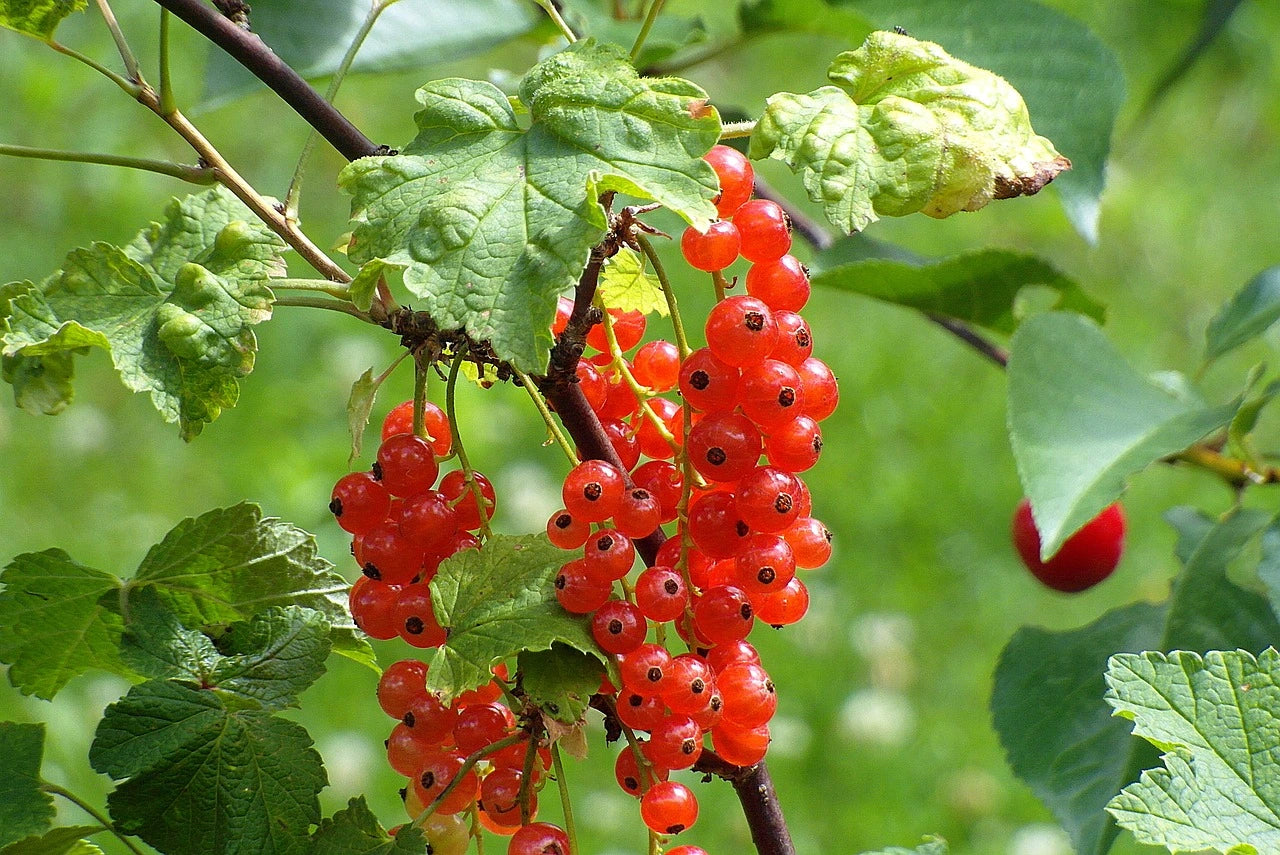
Planting and harvesting calendar for Gooseberries
When to plant gooseberries? When to harvest gooseberries?
Are you looking to start growing gooseberries but don't know when to plant them? Are you also wondering when you'll be harvesting your gooseberries ?
On this page you will find the planting and harvesting periods for each variety of red currant.
| Gooseberry Bushes | Jan | Feb | Mar | Apr | May | Jul | Jul | Aug | Sep | Oct | Nov | Dec | Harvest rate / Production yield | |||||||||||||
|---|---|---|---|---|---|---|---|---|---|---|---|---|---|---|---|---|---|---|---|---|---|---|---|---|---|---|
|
Gooseberry Bush Jonkheer Van Tets |
Planting | 1 year after planting: small harvest 2 years after planting: first yield |
||||||||||||||||||||||||
| Harvest | ||||||||||||||||||||||||||
|
Gooseberry Bush Junifer |
Planting | 1 year after planting: small harvest 2 years after planting: first yield |
||||||||||||||||||||||||
| Harvest | ||||||||||||||||||||||||||
|
Gooseberry Bush Laxton's Perfection |
Planting | 1 year after planting: small harvest 2 years after planting: first yield |
||||||||||||||||||||||||
| Harvest | ||||||||||||||||||||||||||
|
Gooseberry Bush London Market |
Planting | 1 year after planting: small harvest 2 years after planting: first yield |
||||||||||||||||||||||||
| Harvest | ||||||||||||||||||||||||||
|
Gooseberry Bush Rovada |
Planting | 1 year after planting: small harvest 2 years after planting: first yield |
||||||||||||||||||||||||
| Harvest | ||||||||||||||||||||||||||
|
Gooseberry Bush Wilder |
Planting | 1 year after planting: small harvest 2 years after planting: first yield |
||||||||||||||||||||||||
| Harvest | ||||||||||||||||||||||||||
|
Gooseberry Bush Mulka |
Planting | 1 year after planting: small harvest 2 years after planting: first yield |
||||||||||||||||||||||||
| Harvest | ||||||||||||||||||||||||||
|
Gooseberry Bush Glory of the Sablons |
Planting | 1 year after planting: small harvest 2 years after planting: first yield |
||||||||||||||||||||||||
| Harvest | ||||||||||||||||||||||||||
|
Gooseberry Bush Champagne Rose |
Planting | 1 year after planting: small harvest 2 years after planting: first yield |
||||||||||||||||||||||||
| Harvest | ||||||||||||||||||||||||||
|
Gooseberry Bush Bar Le Duc |
Planting | 1 year after planting: small harvest 2 years after planting: first yield |
||||||||||||||||||||||||
| Harvest | ||||||||||||||||||||||||||
|
Gooseberry Bush White Cherry |
Planting | 1 year after planting: small harvest 2 years after planting: first yield |
||||||||||||||||||||||||
| Harvest | ||||||||||||||||||||||||||
|
Gooseberry Bush Red Lake |
Planting | 1 year after planting: small harvest 2 years after planting: first yield |
||||||||||||||||||||||||
| Harvest | ||||||||||||||||||||||||||
|
Gooseberry Bush Red Start |
Planting | 1 year after planting: small harvest 2 years after planting: first yield |
||||||||||||||||||||||||
| Harvest | ||||||||||||||||||||||||||
|
Gooseberry Bush Rolan |
Planting | 1 year after planting: small harvest 2 years after planting: first yield |
||||||||||||||||||||||||
| Harvest | ||||||||||||||||||||||||||
|
Gooseberry Bush Rondom |
Planting | 1 year after planting: small harvest 2 years after planting: first yield |
||||||||||||||||||||||||
| Harvest | ||||||||||||||||||||||||||
| Rosetta Gooseberry | Planting | 1 year after planting: small harvest 2 years after planting: first yield |
||||||||||||||||||||||||
| Harvest | ||||||||||||||||||||||||||
|
Gooseberry Bush Rotet |
Planting | 1 year after planting: small harvest 2 years after planting: first yield |
||||||||||||||||||||||||
| Harvest | ||||||||||||||||||||||||||
|
Gooseberry Bush Blanka |
Planting | 1 year after planting: small harvest 2 years after planting: first yield |
||||||||||||||||||||||||
| Harvest | ||||||||||||||||||||||||||
|
Gooseberry Bush Primus |
Planting | 1 year after planting: small harvest 2 years after planting: first yield |
||||||||||||||||||||||||
| Harvest | ||||||||||||||||||||||||||
| Werdavia Grape Gooseberry Bush | Planting | 1 year after planting: small harvest 2 years after planting: first yield |
||||||||||||||||||||||||
| Harvest | ||||||||||||||||||||||||||
|
Gooseberry Bush White Dutchwoman |
Planting | 1 year after planting: small harvest 2 years after planting: first yield |
||||||||||||||||||||||||
| Harvest | ||||||||||||||||||||||||||
|
Gooseberry Bush White Versailles |
Planting | 1 year after planting: small harvest 2 years after planting: first yield |
||||||||||||||||||||||||
| Harvest | ||||||||||||||||||||||||||
|
Gooseberry Bush Zitavia |
Planting | 1 year after planting: small harvest 2 years after planting: first yield |
||||||||||||||||||||||||
| Harvest | ||||||||||||||||||||||||||
Jonkheer Van Tets Grape Currant: Planting and Harvesting Period
The Jonkheer Van Tets Gooseberry bush is planted from September to November or from February to May. The fruiting/harvesting period for the Jonkheer Van Tets Gooseberry bush is from June to July. The Jonkheer Van Tets Gooseberry bush is a non-remontant variety.
Junifer Grape Currant: Planting and Harvesting Period
Junifer Gooseberry is planted from September to November or from February to May. The fruiting/harvesting period for Junifer Gooseberry is from late June to late July. Junifer Gooseberry is a non-remontant variety.
Laxton's Perfection Gooseberry: Planting and Harvesting Time
Laxton's Perfection Gooseberry is planted from September to November or from February to May. The fruiting/harvesting period for Laxton's Perfection Gooseberry is in July. Laxton's Perfection Gooseberry is a non-everbearing variety.
Gooseberry Bush London Market: Planting and Harvesting Period
The London Market Gooseberry is planted from September to November or from February to May. The fruiting/harvesting period for the London Market Gooseberry is from mid-July to mid-August. The London Market Gooseberry is a non-everbearing variety.
Rovada Gooseberry Bush: Planting and Harvesting Period
The Rovada Gooseberry bush is planted from September to November or from February to May. The fruiting/harvesting period for the Rovada Gooseberry bush is from late July to late August. The Rovada Gooseberry bush is a non-remontant variety.
Wilder Gooseberry Bush: Planting and Harvesting Period
Wilder Gooseberry is planted from September to November or from February to May. The fruiting/harvesting period for Wilder Gooseberry is in July. Wilder Gooseberry is a non-remontant variety.
Mulka Gooseberry Bush: Planting and Harvesting Period
Mulka Gooseberry is planted from September to November or from February to May. The fruiting/harvesting period for Mulka Gooseberry is in August. Mulka Gooseberry is a non-remontant variety.
Gloire des Sablons Gooseberry Bush: Planting and Harvesting Period
The Gloire des Sablons Gooseberry bush is planted from September to November or from February to May. The fruiting/harvesting period for the Gloire des Sablons Gooseberry bush is from mid-July to the end of August. The Gloire des Sablons Gooseberry bush is a non-remontant variety.
Champagne Rose Gooseberry Bush: Planting and Harvesting Period
The Champagne Pink Gooseberry bush is planted from September to November or from February to May. The fruiting/harvesting period for the Champagne Pink Gooseberry bush is from mid-July to mid-August. The Champagne Pink Gooseberry bush is a non-remontant variety.
Bar Le Duc Grape Gooseberry Bush: Planting and Harvesting Period
The Bar Le Duc Gooseberry bush is planted from September to November or from February to May. The fruiting/harvesting period for the Bar Le Duc Gooseberry bush is from late July to late August. The Bar Le Duc Gooseberry bush is a non-remontant variety.
White Cherry Gooseberry Bush: Planting and Harvesting Period
The White Cherry Gooseberry bush is planted from September to November or from February to May. The fruiting/harvesting period for the White Cherry Gooseberry bush is from late July to late August. The White Cherry Gooseberry bush is a non-remontant variety.
Red Lake Gooseberry Bush: Planting and Harvesting Time
Red Lake Gooseberry is planted from September to November or from February to May. The fruiting/harvesting period for Red Lake Gooseberry is from mid-July to the end of August. Red Lake Gooseberry is a non-everbearing variety.
Red Start Gooseberry: Planting and Harvesting Period
Red Start Gooseberry is planted from September to November or from February to May. The fruiting/harvesting period for Red Start Gooseberry is from mid-August to the end of August. Red Start Gooseberry is a non-remontant variety.
Rolan Gooseberry Bush: Planting and Harvesting Period
The Rolan Gooseberry bush is planted from September to November or from February to May. The fruiting/harvesting period for the Rolan Gooseberry bush is from July to August. The Rolan Gooseberry bush is a non-remontant variety.
Rondom Gooseberry Bush: Planting and Harvesting Period
The Rondom Gooseberry bush is planted from September to November or from February to May. The fruiting/harvesting period for the Rondom Gooseberry bush is from mid-July to the end of August. The Rondom Gooseberry bush is a non-remontant variety.
Rosetta Gooseberry Bush: Planting and Harvesting Period
Rosetta Gooseberry is planted from September to November or from February to May. The fruiting/harvesting period for Rosetta Gooseberry is from mid-July to the end of August. Rosetta Gooseberry is a non-remontant variety.
Rotet Grape Gooseberry Bush: Planting and Harvesting Period
The Rotet Gooseberry bush is planted from September to November or from February to May. The fruiting/harvesting period for the Rotet Gooseberry bush is from mid-August to the end of August. The Rotet Gooseberry bush is a non-remontant variety.
Blanka Gooseberry Bush: Planting and Harvesting Period
Blanka Gooseberry is planted from September to November or from February to May. The fruiting/harvesting period for Blanka Gooseberry is from July to August. Blanka Gooseberry is a non-remontant variety.
Primus Gooseberry Bush: Planting and Harvesting Period
Primus Gooseberry is planted from September to November or from February to May. The fruiting/harvesting period for Primus Gooseberry is from mid-June to mid-July. Primus Gooseberry is a non-remontant variety.
Werdavia Gooseberry Bush: Planting and Harvesting Period
The Werdavia Gooseberry bush is planted from September to November or from February to May. The fruiting/harvesting period for the Werdavia Gooseberry bush is from July to August. The Werdavia Gooseberry bush is a non-remontant variety.
White Dutch Gooseberry: Planting and Harvesting Period
The White Dutch Gooseberry is planted from September to November or from February to May. The fruiting/harvesting period for the White Dutch Gooseberry is from mid-July to the end of August. The White Dutch Gooseberry is a non-remontant variety.
White Versaillaise Gooseberry Bush: Planting and Harvesting Period
The White Versaillaise Gooseberry is planted from September to November or from February to May. The fruiting/harvesting period for the White Versaillaise Gooseberry is from July to August. The White Versaillaise Gooseberry is a non-remontant variety.
Zitavia Gooseberry Bush: Planting and Harvesting Period
Zitavia Gooseberry is planted from September to November or from February to May. The fruiting/harvesting period for Zitavia Gooseberry is from July to August. Zitavia Gooseberry is a non-remontant variety.
Which Variety of Gooseberries Should You Choose? Characteristics and Uses of Gooseberries
How to choose your variety of Gooseberry bushes?
You would like to plant Gooseberry bushes on your plot but you don't know which variety of Gooseberry bushes to grow Which grapes to choose? This guide to currant varieties Grappes lists the main varieties along with their characteristics and uses. For farm sales, supermarket sales, or processing? There's something for everyone.
If you are looking for another variety of Gooseberry Grapes do not hesitate to contact us: contact us
Our ranges of Gooseberry bushes Clusters :
Organic Gooseberry Range for Professionals
Conventional Gooseberry Bush Range for Professionals
Gooseberry Variety Guides Clusters :
| Variety | Fruit Color | Remontante | Precocity | Productivity | Fruit Size / Shape | Disease Resistance / Hardiness | Fruiting Period | Taste | Self-fertile |
|---|---|---|---|---|---|---|---|---|---|
| Jonkheer Van Tets | Bright Red | Non-Rising | Early | Very productive variety | Medium to large fruit cluster | Vigorous variety with good disease resistance, adapts to poor soil and is very cold resistant. | June-July | Juicy berries with a sweet taste. Suitable for fresh or for making jam, for example. Its juice is quite dark. The skin is a little thick. | Yes |
| Junifer | Bright red | Non-Rising | Early | Very productive variety | Long bunches | Little need for cooling, suitable for the south of France | End of June to End of July | Perfect for processing because it is rich in pectin, which makes it easier to make jam. | Yes |
| Laxton's Perfection | Dark red | Non-Rising | Season | Very productive variety | Large bunches. Large fruit. | recommended in northern or continental regions with cold winters, good hardiness and disease resistance but average vigor | July | Pleasantly fragrant, sweet and tangy with firm fruit | Yes |
| London Market | Light red | Non-Rising | Mid-Season | Excellent yield. Can reach around 7 kg per plant in optimal conditions. | Long, compact clusters. Large fruit. Round berries. | Very hardy and vigorous variety. Resists down to -15°C. Good disease resistance. Do not plant on plains south of the Loire. | Mid-July to Mid-August | Juicy and tangy pulp, rich in pectin, therefore ideal for processing | Yes |
| Rovada | Red | Non-Rising | Late | Very large production, easy to pick, reliable production, picking can be delayed because the fruit stays on the plant well | Long bunches | Resists fungal and leaf diseases. Attracts bees and butterflies. | End of July to End of August | Very tasty. Fragrant and slightly tangy. Suitable for fresh or processing. | |
| Wilder | Red | Non-Rising | Season | Very productive | Long bunches, medium size | Good disease resistance | July | Very tasty fruit, good sugar-acid balance | Yes |
| Mulka | Dark red | Non-Rising | Late | Very productive | Small berries, long clusters | Moderately vigorous but possible in mountain cultivation because it is very late. Needs soil enriched with organic matter. | August | Very sweet and aromatic fruit | Yes |
| Glory of the Sablons | Light Pink | Non-Rising | Late | Productive variety | Long bunches, medium size | Vigorous variety. Not suitable for calcareous soils. Resists diseases well and down to -20°C. Not very susceptible to diseases except pest attacks. | Mid-July to End of August | Sweet and slightly acidic flavor | Yes |
| Champagne Rose | Pink | Non-Rising | Mid-Season | Good production | Numerous medium-sized clusters | Adapts to all types of soil. Vigorous variety. | Mid-July to Mid-August | Sweet and mild flavor | |
| Bar Le Duc | White | Non-Rising | Late | Average productivity | Medium-sized, narrow cluster | Hardy and moderately vigorous variety | End of July to End of August | Contains very few seeds. Can be used fresh or in processing: sorbet, jam, pastry juice, quite acidic and fragrant. | Yes |
| White Cherry | White-Pink | Non-Rising | Late | Good production. Easy to pick. | Long clusters. Medium-sized fruit. | Good disease resistance but moderately vigorous | End of July to End of August | Firm fruit. Tangy and fragrant taste. Juicy. Very good fresh | Yes |
| Red Lake | Red | Non-Rising | Late | Very productive, easy to pick | Long bunches | Highly resistant to diseases such as powdery mildew and anthracnose | Mid-July to End of August | Good sugar-acid ratio. Very fragrant. Slightly tart. | Yes |
| Red Start | Red | Non-Rising | Very late (after Red Lake) | Good performance | Long clusters. Medium-sized fruit. | Mid-August to late August | Good acidic flavor. Very good for making into jellies. | Yes | |
| Rolan | Bright red | Non-Rising | Season | Very productive variety. Easy to pick. | Long clusters. Medium-sized fruit. | Very disease-resistant variety. High cold requirements. Suitable for harsh winters. | July to August | Very tasty. Slightly tangy. Medium aromatic. Suitable for all uses (fresh or processed) | Yes |
| Rondom | Pale red | Non-Rising | Late | Very productive. Easy to pick. Known for its yield. | Firm fruit. Large, regular-sized berries. Firm | Hardy variety. Good tree retention. High light requirements. Strong immune system. | Mid-July to End of August | Exceptional flavor. Perfect for making into a pie. | Yes |
| Rosetta | Bright red color. Perfect for decoration because of its beautiful color. | Non-Rising | Late | Very productive | Large fruit | The fruit may burst in hot weather after heavy rain | Mid-July to End of August | Perfect for making red fruit coulis or jam. Acidic taste | Yes |
| Rotet | Bright red | Non-Rising | Very late | Reliable variety. Good productivity every year. | Medium to large fruit | Hardier than average variety. Resists splitting after rain. | Mid-August to late August | Very sour taste. Perfect for processing and decoration. | Yes |
| Blanka | Yellow-whitish | Non-Rising | Season | Good productivity (between 6 and 11KG per shrub) | Medium-sized fruit | Very disease resistant but susceptible to powdery mildew | July to August | Juicy and fresh with large seeds | Yes |
| Primus | Translucent white | Non-Rising | Season | High-yielding variety | Medium to large fruit | Retains its quality for a long time on the tree, then takes on a pinkish color. Resistant to diseases but slightly susceptible to mildew | Mid-June to Mid-July | Acidic and juicy. Suitable for fresh or juicy consumption. One of the sweetest white currant varieties. Variety very rich in Vitamin C. | Yes |
| Werdavia | Light Yellow | Non-Rising | Season | Variety with excellent yield potential | Very large bunches | Hardy variety. Very disease resistant. Will withstand cold down to -22°C | July to August | Very tasty and rich in vitamin C. Sweet, tangy and fragrant taste | Yes |
| White Dutchwoman | White tinged with pink | Non-Rising | Late | Variety that offers a good yield | Large berries, long bunches | Reliable variety. Disease resistant. | Mid-July to End of August | Sweet and fragrant flavor. Ideal for fresh consumption. | Yes |
| White Versailles | Translucent white with amber reflection | Non-Rising | Season | Productive variety, easy to harvest | Numerous short bunches, medium-sized fruit | Good disease resistance. Frost resistant down to -15°C. Adapts to all soil types except those with excessive chalkiness. | July to August | Juicy and sweet pulp | Yes |
| Zitavia | Yellow-whitish berries | Non-Rising | Season | High-yielding variety. Up to 7 kg per year/bush | Long bunches, large berries | Variety with fruits that remain on the tree for a long time. Resistant to rain and various diseases. Adapts to all soils. | July to August | Very sweet compared to red berries, juicy and very tasty. Perfect fresh or processed. | Yes |
Gooseberry Market in France in 2025
The French currant market offers promising opportunities for market gardeners, with growing demand for local and organic products, supported by favorable trends in the agri-food, cosmetics, and dietary supplement sectors. However, this crop also presents challenges, including international competition, climatic hazards, and high production costs, requiring tailored strategies to maximize profitability and meet market expectations.
Currants: Presentation and Uses
The gooseberry is a bushy shrub that can reach 1 to 2 meters in height, native to the temperate regions of Europe and Asia . Its fruits, currants, are small red, pink or white berries which grow in clusters of 7 to 20 grains . They have a tangy, sweet flavor, with a shiny, translucent skin .
In France, currants are mainly used in the food industry for the production of jams, jellies and syrups, thanks to their richness in pectin . They are also very popular in baking and dessert decoration . The hospitality sector remains an important outlet, but retail sales are becoming increasingly important, especially in winter . Gooseberries are also made into fruit puree or frozen for use throughout the year .
- Main varieties cultivated in France:
- Jonkher von tets (bright red)
- Glory of the Sands (pale pink)
- White Versailles
Evolution of the Gooseberry Market
The French currant market has seen mixed trends over the past three years. In conventional agriculture, cultivated areas have remained relatively stable, with a slight decrease of 2% between 2022 and 2024 . Production volumes fluctuated depending on weather conditions, with 2023 being a particularly difficult year due to late frost episodes.
The organic market is seeing more positive momentum. The area cultivated with organic currants increased by 9% between 2022 and 2024, in line with the general growth trend in the organic sector in France. This increase is due to growing consumer demand for local and organic products, as well as producers' efforts to diversify their crops. However, organic production volumes remain modest, representing around 14% of total currant sales in France .
- Key points:
- Relative stability of the conventional market
- Significant growth in the organic market (+9% in surface area)
- Production fluctuations linked to climatic hazards
- Growing demand for local and organic products
Current Market Status
The French currant market in 2024 shows contrasting trends between conventional and organic farming. In conventional agriculture, cultivated areas have stabilized at around 1,900 hectares . Conventional production remains dominant, but faces profitability challenges due to competition from neighboring countries such as the Netherlands .
For the organic market, we observe a positive dynamic with an increase in certified areas of 8% in 2023 . New organic farms focus in particular on vegetables and berries . This growth is supported by increased consumer demand for local and organic products, particularly following the health crisis . However, organic production volumes remain modest, representing around 5% of total fruit and vegetable sales . Organic redcurrant prices remain high, with average prices around €23-24/kg for 125g punnets, which may slow consumption but offers opportunities for added value for producers.
Regions and Terroirs of Groseilliers
Hauts-de-France stands out as the leading gooseberry producing region in France, representing 27% of cultivated areas . This region benefits from a cool climate and humus-rich soils that are favorable to growing gooseberries. The Oise region specializes in blackcurrants, while the Aisne region is renowned for its raspberries . Nord-Pas-de-Calais and Somme offer a diversified production of red fruits, including currants.
Other regions such as the Rhône Valley, the Loire Valley and the Côte d'Or also cultivate gooseberries . Gooseberry bushes adapt well to the cool climates of the north of the Loire and to mid-mountain areas, withstanding temperatures down to -25°C . However, they are sensitive to late spring frosts and require cool, well-drained, slightly acidic soils for optimal growth .
- Regional specificities:
- Hauts-de-France: cool climate, humus-rich soils
- Mountainous regions: adaptation to low temperatures
- Southern regions: cultivation in partial shade recommended
Gooseberry Growing Techniques
The main varieties of redcurrants grown in France are 'Jonkheer Van Tets' (bright red, early), 'Versaillaise blanche' (translucent white fruits) and 'Gloire des Sablons' (pale pink) . These shrubs prefer rich, well-drained, slightly acidic soil, with sunny or partially shaded exposure . Irrigation is crucial in spring and summer to ensure good fruiting . The recommended planting density is approximately 1 plant every 1 to 1.5 meters.
Average yields vary between 5 and 8 kg per plant in conventional cultivation, slightly lower in organic farming. Gooseberry bushes come into production in the second year after planting and can remain productive for 15 to 20 years with proper maintenance . Regular pruning, particularly the removal of branches over 4 years old, is essential to maintain productivity .
International Trade and Competition
France occupies a modest position on the international currant market, ranking 6th among European producers with less than 2,000 tonnes per year . World production is dominated by Russia (420,000 tonnes) and Poland (160,000 tonnes) . French imports of currants remain limited, with around 1,000 tonnes per year, mainly from Poland and the Netherlands .
Unlike other small fruits such as raspberries or blueberries, whose imports have increased by more than 100% in recent years, the French redcurrant market remains relatively stable . However, competition from neighbouring countries, particularly Poland, is weighing on the profitability of French producers . This competitive pressure is encouraging domestic producers to turn to higher value-added products, such as organic currants or high-quality processed products, to stand out in the market .
Opportunities for French Producers
The French currant market offers interesting opportunities for producers, both in the conventional and organic sectors. In the conventional sector, diversification into value-added processed products such as artisanal jams or cold-pressed juices represents growth potential. Industrial outlets, particularly in the food and cosmetics industries, are expanding with the increasing use of redcurrant extracts in food supplements and care products .
The outlook for the organic market is particularly promising. Consumer demand for local and organic products continues to grow, providing opportunities for producers to grow . Institutional aid, such as the 94 million euro emergency fund and the increase in the budget of the Organic Agency, support the transition and the promotion of organic products . In addition, the organic fruit and vegetable segment in specialist stores is showing growth of 8.4%, demonstrating sustained interest in these fresh products . Producers can also explore the growing market for organic food supplements, which grew by 2.3% in the last quarter .
Profitability and Financial Aid
There are significant differences in currant production between conventional and organic farming. In organic farming, production costs can be up to 22% higher, mainly due to the specific inputs and additional labor required . However, organic yields are generally 20 to 40% lower than conventional . Despite these differences, the potential profitability of gooseberries remains interesting, with gross margins of up to 700-1000 kg per 1000 m² per year and an average fresh selling price of 14 to 20 euros per kg .
To support the transition to organic farming and crop diversification, several aid schemes are available. Farmers can benefit from aid for conversion (CAB) and maintaining organic farming, as well as an organic tax credit increased to €3,500 . In addition, a support fund of 90 million euros has been set up in 2024 for organic farms in economic difficulty . Producers can also access investment aid from Regional Councils, Water Agencies and ADEME for organic sector development projects .
Sector Challenges and Risks
The market for currants, both conventional and organic, faces specific challenges. In conventional production, competition from low-cost imports, particularly from Poland and the Netherlands, puts pressure on prices . Phytosanitary risks, such as anthracnose and powdery mildew, can significantly affect yields . For organic production, high production costs (around 75% of the total cost) and the fragility of the fruit (storage limited to 48 hours at 10°C) pose logistical and economic challenges . Strict regulations and organic certification costs are also significant constraints . In addition, competition from low-cost imported frozen products threatens direct sales of fresh organic fruit . These combined factors make the organic currant market particularly sensitive to fluctuations in demand and prices.
Innovations and Future Perspectives
The gooseberry sector is experiencing significant advances in innovation and research. Participatory breeding programs aim to develop more hardy and locally adapted population varieties, thus meeting the specific needs of organic farmers . These new genetically heterogeneous varieties offer greater resilience to environmental variations and are part of an agroecological approach.
In the medium term, the gooseberry market is expected to witness sustained growth, driven by the increasing demand for natural and functional products. The gooseberry extract industry, in particular, is expected to reach USD 0.95 billion by 2032, at a CAGR of 9.85% . This growth will be driven by the increased use of gooseberry in food supplements, cosmetic products and functional foods, responding to the consumer trend towards healthier and more natural products .
Recommendations for French Market Gardeners
The integration of gooseberry cultivation presents significant advantages for French market gardeners, including a growing demand for local and organic products, as well as opportunities for diversification towards value-added products . However, this culture also brings challenges, such as competition from low-cost imports and high production costs, particularly in organic farming .
For an informed decision, market gardeners should:
- Favor disease-resistant varieties to reduce phytosanitary treatments .
- Optimize soil fertility through regular additions of organic matter to improve yields .
- Consider growing under cover to extend the season and protect against adverse weather conditions .
- Explore processing opportunities (jams, juices) to enhance production and reduce losses .
- Consider organic certification to benefit from a growing market and conversion aids .
By adopting these strategies, French market gardeners can take advantage of the potential of growing gooseberries while minimizing the associated risks.
Plant Suppliers and Advice
To obtain quality gooseberry plants or advice on planting a plot, two specialist suppliers stand out:
Bairiverse ( https://plantspetitsfruits.com/ ) offers a wide range of small fruit plants, including gooseberries, tailored to the needs of professionals. Their offer includes plants in mini-plugs, pots and containers, available in organic and conventional versions . Bairiverse stands out for its commercial responsiveness and technical expertise, offering personalized support from varietal selection to planting .
Econome à Légumes ( https://economealegumes.fr/ ) is a trader in plants and plant material offering aggressive prices directly to producers . Their range includes gooseberry plants and other small fruits, with deliveries guaranteed throughout France. Econome à Légumes also offers technical advice and personalized support to optimize your crops .
These two suppliers guarantee quality plants, fast delivery and technical support adapted to the needs of professional market gardeners.
FAQ Small Fruits: all our planting tips
Find here all our technical itineraries and cultivation guides to optimize your berry yields
Maximize the production and quality of your crops with our technical itineraries
Whether you're a professional market gardener, nurseryman, or crop manager, accessing best practices and technical itineraries is essential to maximizing the yield and quality of your berry harvests. Through a selection of detailed articles and guides, you can benefit from advice on planting techniques, disease and pest management, as well as methods for preserving and optimizing production.
Explore each guide to get proven solutions, specific to the challenges of your operation, and benefit from the technical support of Bairiverse , your supplier of professional quality berry plants in France.
Raspberry bushes:
Which raspberry variety should you choose? Characteristics and uses of raspberry plants
Raspberry Planting and Harvesting Calendar
Blueberry bushes
Which blueberry variety should you choose? Characteristics and uses of blueberries
Planting and Harvesting Calendar for Blueberries
Definition: Blueberry varieties High Chill, Mid Chill, Low Chill and Rabbiteye
Mulberry trees
Which variety of mulberry should you choose? Characteristics and uses of mulberry trees
Planting and Harvesting Calendar for Mulberry Trees
Gooseberry Bushes
Which Variety of Gooseberries Should You Choose? Characteristics and Uses of Gooseberries
Planting and harvesting calendar for Gooseberries
Gooseberry bushes
Which variety of gooseberry should you choose? Characteristics and uses of gooseberries
Planting and Harvesting Calendar for Gooseberries
Blackcurrant bushes
Which variety of blackcurrant should you choose? Characteristics and uses of blackcurrants

